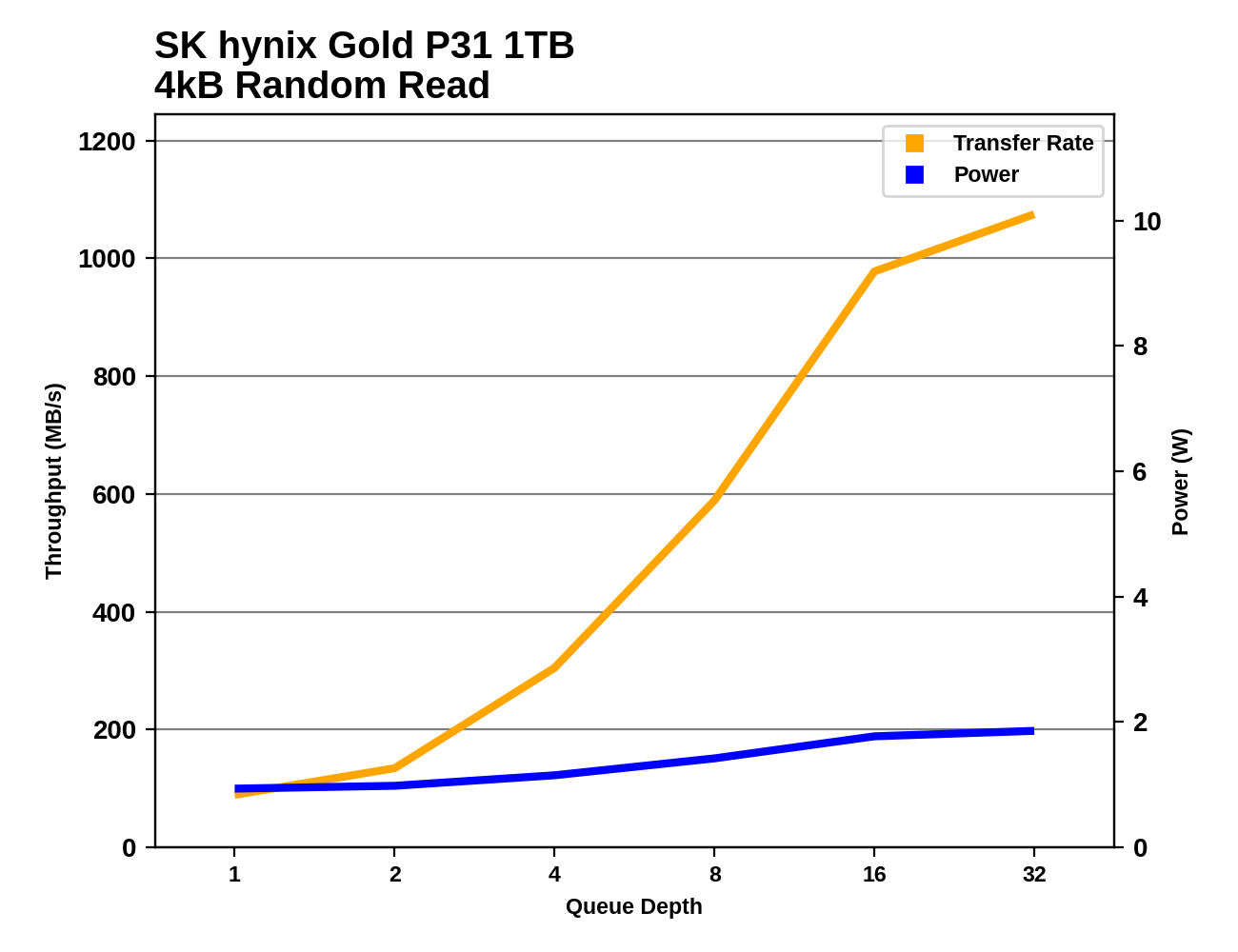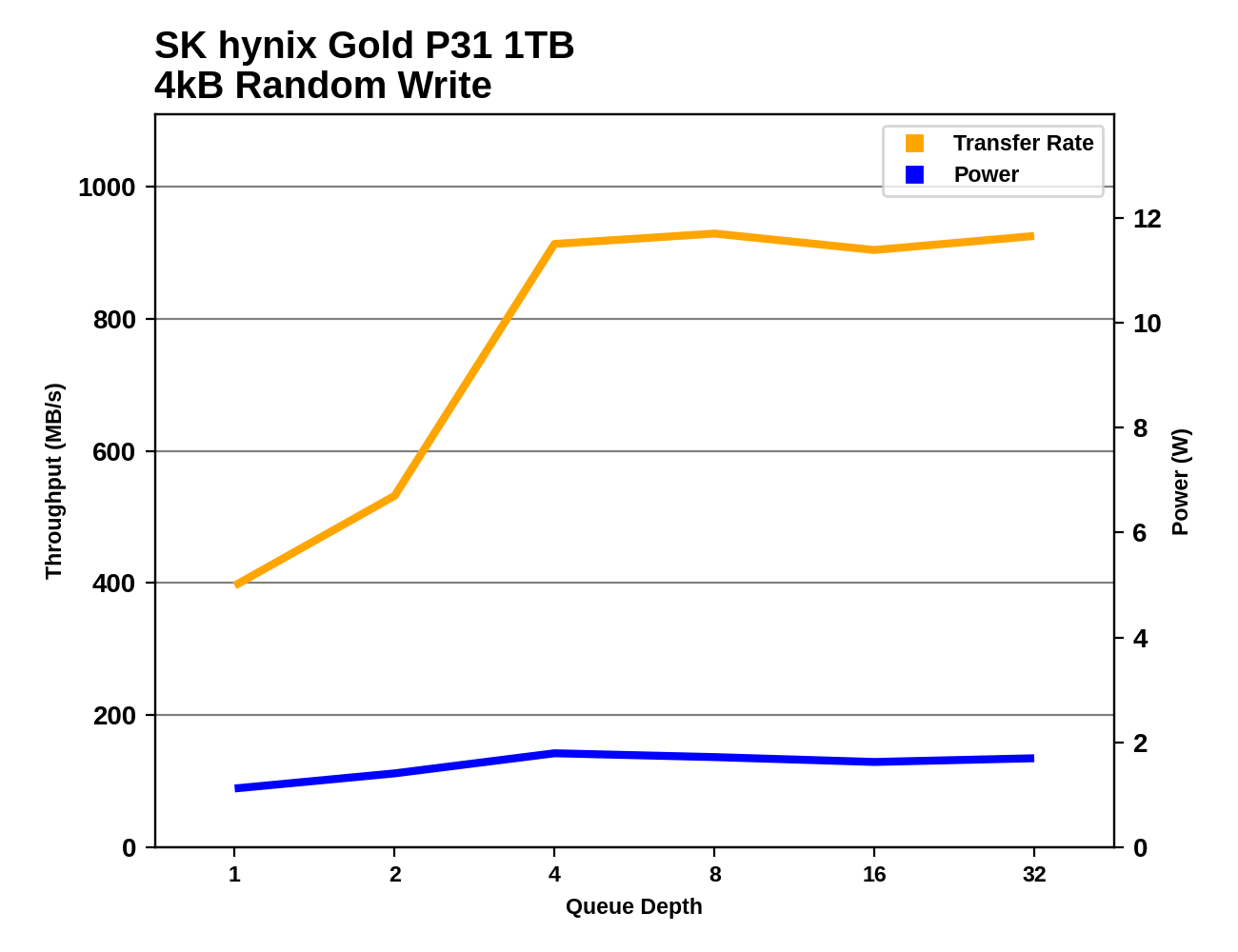The Best NVMe SSD for Laptops and Notebooks: SK hynix Gold P31 1TB SSD Reviewed
by Billy Tallis on August 27, 2020 8:00 AM ESTRandom Read Performance
Our first test of random read performance uses very short bursts of operations issued one at a time with no queuing. The drives are given enough idle time between bursts to yield an overall duty cycle of 20%, so thermal throttling is impossible. Each burst consists of a total of 32MB of 4kB random reads, from a 16GB span of the disk. The total data read is 1GB.

The QD1 burst random read performance of the SK hynix Gold P31 is similar to what we see from drives using the Silicon Motion SM2262EN controller, which has dominated this test since it hit the market.
Our sustained random read performance is similar to the random read test from our 2015 test suite: queue depths from 1 to 32 are tested, and the average performance and power efficiency across QD1, QD2 and QD4 are reported as the primary scores. Each queue depth is tested for one minute or 32GB of data transferred, whichever is shorter. After each queue depth is tested, the drive is given up to one minute to cool off so that the higher queue depths are unlikely to be affected by accumulated heat build-up. The individual read operations are again 4kB, and cover a 64GB span of the drive.

On the longer random read test that reaches into higher queue depths, the Gold P31 pulls narrowly ahead of the SX8200 Pro to set a new record for TLC-based SSDs.
 |
|||||||||
| Power Efficiency in MB/s/W | Average Power in W | ||||||||
The power draw of the Gold P31 is only a hair above that of its SATA sibling, the Gold S31. But the P31 is delivering almost three times the performance of that drive, and twice the performance per Watt of the next most efficient drive.
 |
|||||||||
The Gold P31 delivers class-leading performance across the entire range of queue depths covered by this test. Its performance is starting to taper off by QD32, but at that point it has caught up with the throughput of the Optane 905P. The widest margins over other TLC SSDs are around QD8 through QD16. Power consumption remains very low throughout the test, not even reaching 2W at QD32 - that 2x efficiency advantage over the competition remains just as true at high queue depths.
Plotting the P31's results against the entire benchmark database shows that the P31 stakes out new territory. The closest competition on the power/performance landscape are the tiny Intel Optane Memory M.2 drives, and at QD4 or higher all the other flash-based SSDs need considerably more power to deliver the same performance (at QD4 and below, the P31 is still in SATA performance territory where there are more low-power competitors).
Random Write Performance
Our test of random write burst performance is structured similarly to the random read burst test, but each burst is only 4MB and the total test length is 128MB. The 4kB random write operations are distributed over a 16GB span of the drive, and the operations are issued one at a time with no queuing.

The burst random write performance of the Gold P31 is lackluster: slower than most high-end NVMe drives, though actually still a bit faster than the Samsung 970 EVO Plus.
As with the sustained random read test, our sustained 4kB random write test runs for up to one minute or 32GB per queue depth, covering a 64GB span of the drive and giving the drive up to 1 minute of idle time between queue depths to allow for write caches to be flushed and for the drive to cool down.

On the longer random write test that includes some higher queue depths, the high-end NVMe drives mostly have fairly similar scores, and the P31 falls in the middle of the pack for performance.
 |
|||||||||
| Power Efficiency in MB/s/W | Average Power in W | ||||||||
Once again, the power consumption of the Gold P31 is more in line with low-power SATA or DRAMless NVMe drives, even though it offers high-end performance. This time, the efficiency score isn't quite twice that of the next best competitor, but a 75% improvement is still impressive.
 |
|||||||||
The performance profile for the Gold P31 on the random write test is fairly typical: fill performance is reached at QD4, and performance is mostly steady through the rest of the test. The P31 starts out slightly slower at QD1, but at full speed it is definitely competitive.
Comparing the Gold P31's random write performance against our entire database of results shows it standing out even more clearly than it did for the random read results. The QD1 random write performance is already beyond the reach of SATA drives, and none of the other NVMe drives we've tested operate at such low power levels.












80 Comments
View All Comments
surt - Thursday, August 27, 2020 - link
Am i the odd one out that hasn't needed to use a hard drive tool in years?HardwareDufus - Thursday, August 27, 2020 - link
i don't think so. i've been in the industry for over 30 years. back in those days, some harddrives came with error lists that you had to key into a system bios. then there were all the size limits that require creating multiple partitions... the list goes on...but I think other than running scan disk once a year and my scheduled trims.... I haven't used a harddrive tool on my personal PCs and laptops for over 8 years.
plopke - Thursday, August 27, 2020 - link
For me only once with Samsung it was needed , the other times where it was offered but not needed was crucial /sandisk for slight improved performance or compatibility. I just found it very awkward to not have a website showing specifications or support tools at all.Holliday75 - Thursday, August 27, 2020 - link
Nope. I have no updated the firmware on a SSD in 5+ years. That includes work.MikeMurphy - Friday, August 28, 2020 - link
My practice is to update firmware before I install a fresh copy of Windows. Often I'm greeted with some improved firmware for which I'm grateful. I've been happy with the support on my Crucial, Intel and Samsung drives.TheinsanegamerN - Monday, August 31, 2020 - link
Literally have never updated firmware on any SSD. Also only had issues with 1 SSD where the controller straight up died.Tomatotech - Thursday, August 27, 2020 - link
I've only ever used them as a last resort when trying to rescue a failing SSD (and I've had a couple) - they were useless anyway, might as well not bother. Both times when the drive died the manufacturer happily replaced the drive.With today's cloud tech it's easier than ever to keep a 1TB drive constantly backed up & synced (different things) to several different places. OneDrive offers 1TB, iCloud offers 2TB, etc, and usually anything apart from office docs, project files, and photos doesn't even need to be backed up.
TheinsanegamerN - Monday, August 31, 2020 - link
That only applies to the 1% who can get fiber internet. Ever try to back up 1TB of stuff over a cable connection, usually with a 3-5Mbps upload speed?For most people an external HDD is more usable as a backup method then any cloud storage.
Srikzquest - Thursday, August 27, 2020 - link
Hi Billy, I see that the benchmarks are equally compelling on the performance side as well in addition to power efficiency. Then, why its only the standard for Laptops and not Desktops. Is it due to PCIe gen4 drives on the market?Billy Tallis - Thursday, August 27, 2020 - link
The P31 is definitely a good choice for desktops, but it's not the only reasonable choice—while for laptops, it pretty much is at the moment. Since desktop users have little reason to worry about SSD power efficiency, it can make sense to go with something like a cheaper, somewhat slower Phison E12 drive or even something more low-end, because the real-world performance difference between the P31 and a decent low-end NVMe drive (or even a good SATA drive) is pretty small for most use cases. There's also the 2TB market to consider, since the Platinum P31 isn't available yet.